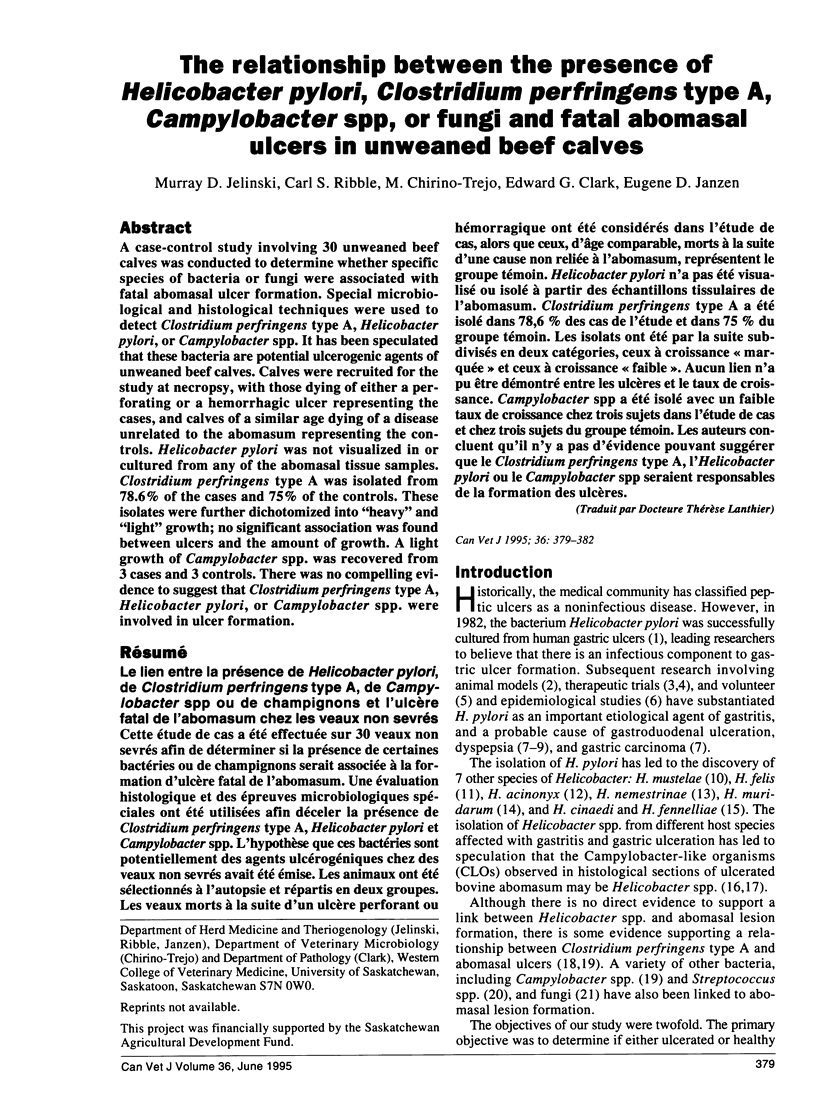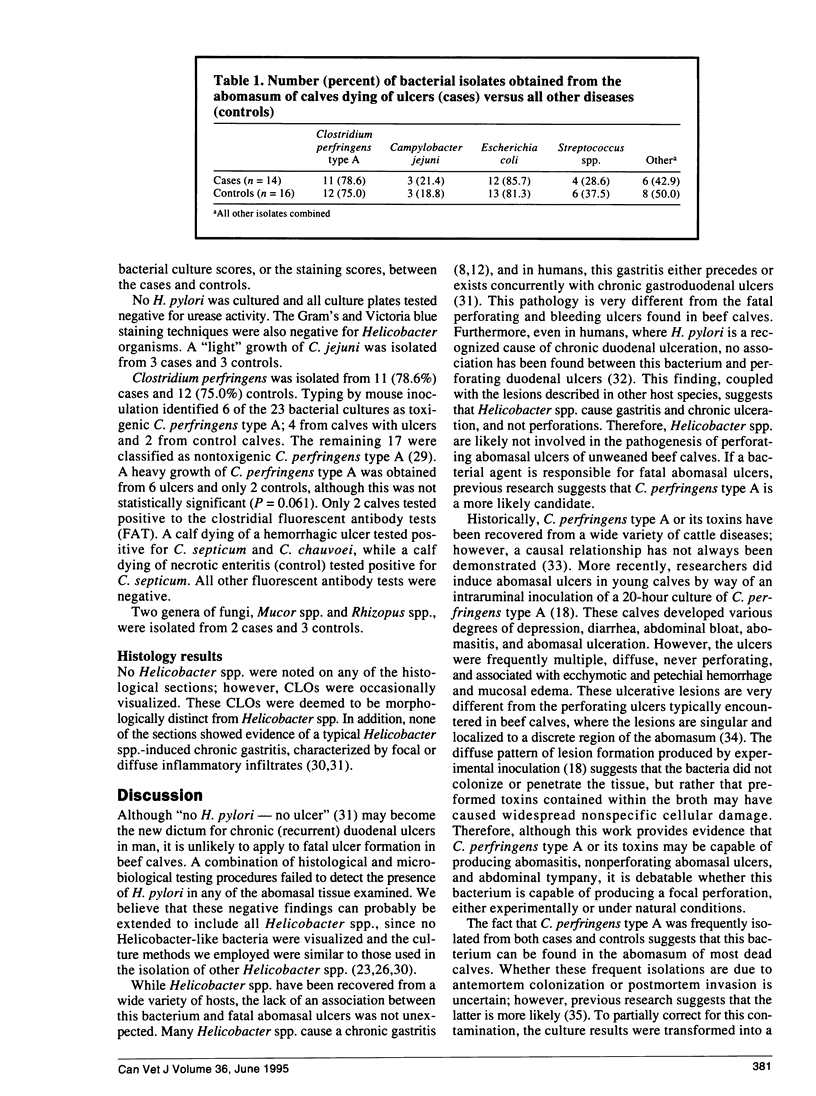Abstract
A case-control study involving 30 unweaned beef calves was conducted to determine whether specific species of bacteria or fungi were associated with fatal abomasal ulcer formation. Special microbiological and histological techniques were used to detect Clostridium perfringens type A, Helicobacter pylori, or Campylobacter spp. It has been speculated that these bacteria are potential ulcerogenic agents of unweaned beef calves. Calves were recruited for the study at necropsy, with those dying of either a perforating or a hemorrhagic ulcer representing the cases, and calves of a similar age dying of a disease unrelated to the abomasum representing the controls. Helicobacter pylori was not visualized in or cultured from any of the abomasal tissue samples. Clostridium perfringens type A was isolated from 78.6% of the cases and 75% of the controls. These isolates were further dichotomized into "heavy" and "light" growth; no significant association was found between ulcers and the amount of growth. A light growth of Campylobacter spp. was recovered from 3 cases and 3 controls. There was no compelling evidence to suggest that Clostridium perfringens type A, Helicobacter pylori, or Campylobacter spp. were involved in ulcer formation.
Full text
PDF



Selected References
These references are in PubMed. This may not be the complete list of references from this article.
- Barthel J. S., Everett E. D. Diagnosis of Campylobacter pylori infections: the "gold standard" and the alternatives. Rev Infect Dis. 1990 Jan-Feb;12 (Suppl 1):S107–S114. doi: 10.1093/clinids/12.supplement_1.s107. [DOI] [PubMed] [Google Scholar]
- Blaser M. J. Epidemiology and pathophysiology of Campylobacter pylori infections. Rev Infect Dis. 1990 Jan-Feb;12 (Suppl 1):S99–106. doi: 10.1093/clinids/12.supplement_1.s99. [DOI] [PubMed] [Google Scholar]
- Blaser M. J. Gastric Campylobacter-like organisms, gastritis, and peptic ulcer disease. Gastroenterology. 1987 Aug;93(2):371–383. doi: 10.1016/0016-5085(87)91028-6. [DOI] [PubMed] [Google Scholar]
- Bronsdon M. A., Goodwin C. S., Sly L. I., Chilvers T., Schoenknecht F. D. Helicobacter nemestrinae sp. nov., a spiral bacterium found in the stomach of a pigtailed macaque (Macaca nemestrina) Int J Syst Bacteriol. 1991 Jan;41(1):148–153. doi: 10.1099/00207713-41-1-148. [DOI] [PubMed] [Google Scholar]
- Dooley C. P., Cohen H. The clinical significance of Campylobacter pylori. Ann Intern Med. 1988 Jan;108(1):70–79. doi: 10.7326/0003-4819-108-1-70. [DOI] [PubMed] [Google Scholar]
- Eaton K. A., Dewhirst F. E., Radin M. J., Fox J. G., Paster B. J., Krakowka S., Morgan D. R. Helicobacter acinonyx sp. nov., isolated from cheetahs with gastritis. Int J Syst Bacteriol. 1993 Jan;43(1):99–106. doi: 10.1099/00207713-43-1-99. [DOI] [PubMed] [Google Scholar]
- Eaton K. A., Radin M. J., Kramer L., Wack R., Sherding R., Krakowka S., Fox J. G., Morgan D. R. Epizootic gastritis associated with gastric spiral bacilli in cheetahs (Acinonyx jubatus). Vet Pathol. 1993 Jan;30(1):55–63. doi: 10.1177/030098589303000107. [DOI] [PubMed] [Google Scholar]
- Graham D. Y. Campylobacter pylori and peptic ulcer disease. Gastroenterology. 1989 Feb;96(2 Pt 2 Suppl):615–625. doi: 10.1016/s0016-5085(89)80057-5. [DOI] [PubMed] [Google Scholar]
- Graham D. Y., Go M. F. Helicobacter pylori: current status. Gastroenterology. 1993 Jul;105(1):279–282. doi: 10.1016/0016-5085(93)90038-e. [DOI] [PubMed] [Google Scholar]
- Günther H., Schulze F. Histologische Untersuchungen zum Vorkommen von Campylobacter ähnlich geformten Keimen im Labmagen von Kälbern. Zentralbl Veterinarmed B. 1992 Dec;39(10):737–745. [PubMed] [Google Scholar]
- Haringsma P. C., Mouwen J. M. Mogelijke betekenis van spirilvormige bacterien bij het ontstaan van lebmaagzweren bij het volwassen rund. Tijdschr Diergeneeskd. 1992 Sep 1;117(17):485–487. [PubMed] [Google Scholar]
- Hentschel E., Brandstätter G., Dragosics B., Hirschl A. M., Nemec H., Schütze K., Taufer M., Wurzer H. Effect of ranitidine and amoxicillin plus metronidazole on the eradication of Helicobacter pylori and the recurrence of duodenal ulcer. N Engl J Med. 1993 Feb 4;328(5):308–312. doi: 10.1056/NEJM199302043280503. [DOI] [PubMed] [Google Scholar]
- Lee A., Fox J. G., Otto G., Murphy J. A small animal model of human Helicobacter pylori active chronic gastritis. Gastroenterology. 1990 Nov;99(5):1315–1323. doi: 10.1016/0016-5085(90)91156-z. [DOI] [PubMed] [Google Scholar]
- Lee A., Hazell S. L., O'Rourke J., Kouprach S. Isolation of a spiral-shaped bacterium from the cat stomach. Infect Immun. 1988 Nov;56(11):2843–2850. doi: 10.1128/iai.56.11.2843-2850.1988. [DOI] [PMC free article] [PubMed] [Google Scholar]
- Lee A., Phillips M. W., O'Rourke J. L., Paster B. J., Dewhirst F. E., Fraser G. J., Fox J. G., Sly L. I., Romaniuk P. J., Trust T. J. Helicobacter muridarum sp. nov., a microaerophilic helical bacterium with a novel ultrastructure isolated from the intestinal mucosa of rodents. Int J Syst Bacteriol. 1992 Jan;42(1):27–36. doi: 10.1099/00207713-42-1-27. [DOI] [PubMed] [Google Scholar]
- Mantzaris G. J., Hatzis A., Tamvakologos G., Petraki K., Spiliades C., Triadaphyllou G. Prospective, randomized, investigator-blind trial of Helicobacter pylori infection treatment in patients with refractory duodenal ulcers. Healing and long-term relapse rates. Dig Dis Sci. 1993 Jun;38(6):1132–1136. doi: 10.1007/BF01295732. [DOI] [PubMed] [Google Scholar]
- Mills K. W., Johnson J. L., Jensen R. L., Woodard L. F., Doster A. R. Laboratory findings associated with abomasal ulcers/tympany in range calves. J Vet Diagn Invest. 1990 Jul;2(3):208–212. doi: 10.1177/104063879000200310. [DOI] [PubMed] [Google Scholar]
- Morris A., Nicholson G. Ingestion of Campylobacter pyloridis causes gastritis and raised fasting gastric pH. Am J Gastroenterol. 1987 Mar;82(3):192–199. [PubMed] [Google Scholar]
- Niilo L. Clostridium perfringens in animal disease: a review of current knowledge. Can Vet J. 1980 May;21(5):141–148. [PMC free article] [PubMed] [Google Scholar]
- Olson L. D. Staining of histologic sections of colon with victoria blue 4-R as an aid in the diagnosis of swine dysentery. Am J Vet Res. 1973 Jun;34(6):853–854. [PubMed] [Google Scholar]
- Reinbach D. H., Cruickshank G., McColl K. E. Acute perforated duodenal ulcer is not associated with Helicobacter pylori infection. Gut. 1993 Oct;34(10):1344–1347. doi: 10.1136/gut.34.10.1344. [DOI] [PMC free article] [PubMed] [Google Scholar]
- Roeder B. L., Chengappa M. M., Nagaraja T. G., Avery T. B., Kennedy G. A. Experimental induction of abdominal tympany, abomasitis, and abomasal ulceration by intraruminal inoculation of Clostridium perfringens type A in neonatal calves. Am J Vet Res. 1988 Feb;49(2):201–207. [PubMed] [Google Scholar]
- Stanley J., Linton D., Burnens A. P., Dewhirst F. E., Owen R. J., Porter A., On S. L., Costas M. Helicobacter canis sp. nov., a new species from dogs: an integrated study of phenotype and genotype. J Gen Microbiol. 1993 Oct;139(10):2495–2504. doi: 10.1099/00221287-139-10-2495. [DOI] [PubMed] [Google Scholar]
- Totten P. A., Fennell C. L., Tenover F. C., Wezenberg J. M., Perine P. L., Stamm W. E., Holmes K. K. Campylobacter cinaedi (sp. nov.) and Campylobacter fennelliae (sp. nov.): two new Campylobacter species associated with enteric disease in homosexual men. J Infect Dis. 1985 Jan;151(1):131–139. doi: 10.1093/infdis/151.1.131. [DOI] [PubMed] [Google Scholar]
- Unidentified curved bacilli on gastric epithelium in active chronic gastritis. Lancet. 1983 Jun 4;1(8336):1273–1275. [PubMed] [Google Scholar]
- Vance H. N. Clostridium perfringens as a pathogen of cattle: a literature review. Can J Comp Med Vet Sci. 1967 Oct;31(10):248–250. [PMC free article] [PubMed] [Google Scholar]


